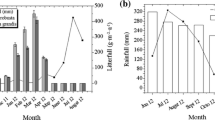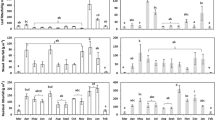Abstract
Litterfall and its subsequent decomposition in the soil are two essential ecosystem processes. In order to determine the biological potential of a species to aid soil restoration, it is necessary to evaluate litter production, its temporal variation, and rates of decomposition and nutrient cycling. In this study, we examined patterns of litterfall production, quality, and decomposition of two slow-growing (Crescentia alata and Eysenhardtia polystachya) and two fast-growing (Leucaena leucocephala and Pithecellobium dulce), multi-purpose indigenous species from seasonally dry tropical forest, in a 10-year-old plantation in Morelos, Mexico. Average litterfall was 7.82 ± 2.69 Mg ha−1 year−1 and varied significantly among species as follows: P. dulce > L. leucocephala > C. alata = E. polstachya. Leaf litter comprised the highest fraction in all species studied. In a litterbag experiment, all species had fast mass loss in the first 183 days of decomposition, coinciding with the rainy season. L. leucocephala had significantly higher decomposition than the other species. Nitrogen percentages increased significantly as decomposition progressed for all species except for E. polystachya while Carbon percentages during decomposition significantly decreased only in C. alata and L. leucocephala. C. alata had the highest average C/N ratio and L. leucocephala the lowest. We recommended for soil biological restoration, P. dulce because it is a fast-growing tree, with a rapid canopy closure and a high litter production and L. Leucocephala, which produces large amounts of rapidly decomposing mulch with high amount of nutrients, which can be rapidly released into the soil.





Similar content being viewed by others
References
Addicott T (1978) Abscisión strategies in the behavior of tropical trees. In: Tomson PB, Zimmermann MH (eds) Tropical Trees as living systems. Cambridge University Press, Cambridge, pp 381–400
Aerts R (1997) Climate, leaf litter chemistry and leaf litter decomposition in terrestrial ecosystems: a triangular relationship. Oikos 79:439–449
Álvarez-Sánchez J (2001) Descomposición y ciclo de nutrientes en ecosistemas terrestres de México. Acta Zoo Mex 1:11–27
Anderson JM, Swift MJ (1983) Decomposition in tropical forest. In: Sutton SL, Whitmore TC, Chadwick AC (eds) Tropical rain forest: ecology and management. Blackwell, Oxford, pp 287–309
Attignon SE, Weibel D, Lachat T, Sinsin B, Nagel P, Peveling R (2004) Leaf litter breakdown in natural and plantation forests of the Lama forest reserve in Benin. Appl Soil Ecol 27:109–124
Barlow J, Gardner TA, Ferreira LV, Peres CA (2007) Litter fall and decomposition in primary, secondary and plantation forests in the Brazilian Amazon. Forest Ecol Manag 247:91–97
Batis MAI, Alcocer MI, Gual M, Sánchez C, Vazquez-Yanez C (1999) Árboles y arbustos nativos potencialmente valiosos para la restauración ecológica y la reforestación. CONABIO, México
Berg B, Mc Claugherty C (2008) Plant litter decomposition, humus formation carbon secuestration. Springer, Berlin
Bourlière F, Hadley M (1970) The ecology of tropical savannas. Ann Rev Ecol Evol Syst 1:125–152
Bullock SH, Solis-Magallanes JA (1990) Phenology of canopy trees of a tropical deciduous forest in Mexico. Biotropica 22:22–35
Byard R, Lewis KC, Montagnini F (1996) Leaf litter decomposition and mulch performance from mixed and monospecific plantations of native tree species in Costa Rica. Agric Ecosyst Environ 58:145–155
Campo J, Vázquez-Yanes C (2004) Effects of nutrient limitation on aboveground carbon dynamics during tropical dry forest regeneration in Yucatan, Mexico. Ecosystems 7(3):311–319
Ceccon E (2011) Los bosques tropicales estacionalmente secos: ¿una prueba ácida para la restauración? In: Vargas-Ríos O, Reyes S PB (Eds.). La Restauración Ecológica en la Práctica. Memorias en extenso del I Congreso Colombiano de Restauración Ecológica y II Simposio Nacional de Experiencias en Restauración. Universidad Nacional de Colombia, pp 119–130
Ceccon E (2013) Restauración en bosques tropicales: fundamentos ecológicos, prácticos y sociales. Ediciones Díaz de Santos/UNAM, Mexico. ISBN 978-84-9969-615-7
Ceccon E, Huante P, Rincón E (2006) Abiotic factors influencing tropical dry forest regeneration. Braz Arch Biol Techn BABT 49(2):305–312
Ceccon E, Almazo-Rogel A, Martínez-Romero E, Toledo I (2012) The effect of inoculation of indigenous bacteria on the early growth of Acacia farnesiana in a degraded area. Rev CERNE 18(1):49–57
Cervantes-Sánchez MA (1994) Calendario fenológico de 4 especies de latifoliadas de Selva Baja Caducifolia del Estado de Morelos En: Informe Anual del Centro de Investigaciones Regionales del Centro Campo Experimental de Zacatepec Morelos SAGAR. INIFAP, Mexico, pp 17–26
Chapin FS (1980) The mineral nutrition of wild plants. Annu Rev Ecol Evol Syst 11:233–260
Descheemaeker K, Muys B, Nyssen J, Poesen J, Raes D, Haile M, Deckers J (2006) Litter production and organic matter accumulation in exclosures of the Tigray highlands, Ethiopia. Forest Ecol Manag 233:21–35
Dobson AP, Bradshaw AD, Baker AA (1997) Hopes for the future: restoration ecology and conservation biology. Science 277(5325):515–522
Ewel J (1976) Litter fall and leaf decomposition in a tropical forest succession in eastern Guatemala. J Ecol 64(1):293–308
FAO–UNESCO (1988) FAO–UNESCO Soil Map of the World—Revised Legend (Reprint of FAO World Soil Resources Report 60). Technical Paper 20, International Soil Reference and Information Centre, Wageningen
García E (1987) Modificaciones al sistema de clasificación climática de Köppen. Universidad Nacional Autonoma de Mexico, Mexico, p 220
Goma-Tchimbakala J, Bernhard-Reversat F (2006) Comparison of litter dynamics in three plantations of an indigenous timber-tree species (Terminalia superba) and a natural tropical forest in Mayombe, Congo. Forest Ecol Manag 229:304–313
Heal OW, Anderson JM, Swift MJ (1997) Plant litter quality and decomposition: An historical overview. In: Cadish G, Giller KE (eds) Driven by nature: plant litter quality and decomposition. Cab Publishing, New York, pp 3–30
Hector A, Beale AJ, Minns A, Otway SJ, Lawton JH (2000) Consequences of the reduction of plant diversity for litter decomposition: effects through litter quality and microenvironment. Oikos 90:357–371
Holl KD (1999) Factors limiting tropical rain forest regeneration in abandoned pasture: seed rain, seed germination, microclimate, and soil. Biotropica 31:229–242
Janzen DH (1983) Costa Rican Natural History. The university of Chicago Press, Chicago
Jaramillo V, Sandford RL (1995) Nutrient cycling in tropical deciduous forests. In: Bullock SH, Mooney HA, Medina F (eds) Seasonality dry tropical forests. Cambridge University Press, Cambridge, pp 346–361
Kaneko N, Salamanca EF (1999) Mixed leaf litter effects on decomposition rates and soil microarthropod communities in an oak-pine stand in Japan. Ecol Res 14:131–138
Leitão FHM, Marques MCM, Ceccon E (2010) Young restored forests increase seedling recruitment in abandoned pastures in the Atlantic rainforest. Rev Biol Trop 58(4):1271–1282
Lisanework N, Michelsen A (1994) Litterfall and nutrient release by decomposition in three plantations compared with a natural forest in the Ethiopian highland. Forest Ecol Manag 65:149–164
Martínez-Yrízar A (1995) Biomass distribution and primary productivity of tropical dry forest. In: Bullock SH, Mooney HA, Medina F (eds) Seasonality dry tropical forests. Cambridge University Press, Cambridge, pp 326–345
Melillo JM, Aber JD, Linkins AE, Ricca A, Fry B, Nadelhoffer J (1989) Carbon and nitrogen dynamics along the decay continuum: plant litter to soil organic matter. Plant Soil 115:189–198
Miles L, Newton AC, DeFries RS, Ravilious C, May I, Blyth S, Kapos V, Gordon JE (2006) A global overview of the conservation status of tropical dry forests. J Biogeogr 33:491–505
Montagnini F (2000) Accumulation in above-ground biomass and soil storage of mineral nutrients in pure and mixed plantations in humid tropical lowland. Forest Ecol Manag 134:257–270
Montagnini F, Sancho F, Ramstad K (1993) Litter fall, litter decomposition and the use of mulch of four indigenous tree species in the Atlantic lowlands of Costa Rica. Agroforest Syst 23:39–61
Nuñez-Quevedo S (1998) Producción de hojarasca, dinámica de mantillo, descomposición foliar y potencial microbiano del suelo en tres comunidades contrastantes del desierto de Sonora. Dissertation, Facultad de Ciencias. UNAM, Mexico
Olson JS (1963) Energy storage and the balance of producers and decomposers in ecological systems. Ecology 44:322–331
Ornelas RF, Ambriz R, Bustamante JD (1997) Delimitación y definición de agrohábitats del estado de morelos. Publicación Especial, 11. INIFAP, New York
Palm CA, Sanchez PA (1990) Decomposition and nutrient release patterns of the leaves of three tropical legumes. Biotropica 22(4):330–338
Parrotta JA (1991) Pithecellobium dulce (Roxb.) Benth. Guamùchil, Madras thorn. SO-ITF-SM-40. Department of Agriculture, Forest Service, Southern Forest Experiment Station. New Orleans, p 5
Parrotta JA (1992) Leucaena leucocpehala (Lam.) de Wit. Leucaena, tantan. SO-ITF-SM-52. Department of Agriculture, Forest Service, Southern Forest Experiment Station, New Orleans. 8 p
Parrotta JA (1999) Productivity, nutrient cycling, and succession in sigle- and mixed-species plantations of Casuarina equisetifolia, Eucalyptus robusta and Leucaena leucocephala in Puerto Rico. Forest Ecol Manag 124:45–77
Pérez-Negron E, Casas A (2007) Use, extraction rates and spatial availability of plant resources in the Tehuacán-Cuicatlán Valley, México: the case of Santiago Quiotepec, Oaxaca. J Arid Environ 70:356–379
Pomeroy LR (1970) The strategy of mineral cycling. Annu Rev Ecol Syst 1:17–190
Roy S, Singh JS (1994) Consequences of habitat heterogeneity for availability of nutrients in a dry tropical forest. J Ecol 82:503–509
Sachman RB (2004) Efecto de la introducción de especies en la recuperación de la dinámica de C y N de un sitio perturbado de SBC en Chamela, Jal. Dissertation. Instituto de Ecología. UNAM, México
SAGARPA-INIFAP (2001) Diagnostico Forestal del Estado de Morelos. Publicación especial, 7, SAGARPA-INIFAP, New York, pp 169
Shelton H, Brewbaker JL (1994) Leucaena leucocephala: the most widely used forage tree legume. In: Gutteridge HM, Shelton RC (eds) Forage tree legumes in tropical agriculture. CAB International, Wallingford, pp 15–29
Singh KP (1969) Studies in decomposition of leaf litter of important trees of tropical deciduous forest at Varanasi. Trop Ecol 10:292–311
Sundarapandian SM, Swamy PS (1999) Litter production and leaf-litter decomposition of selected tree species in tropical forests at Kodayar in Western Ghats, India. Forest Ecol Manag 123:231–244
Tian G, Kang BT (1992) Brussaard L (1992) Biological effects of plant residues with contrasting chemical compositions under humid tropical conditions—Decomposition and nutrient release. Soil Biol Biochem 24:1051–1060
Trejo I, Dirzo R (2000) Deforestation of seasonally dry tropical forest: a national and local analysis in México. Biol Cons 94:133–142
Valle-Arango JI (2003) Descomposición de la hojarasca fina en bosques pantanosos del pacífico colombiano. Interciencia 28(3):148–153
Vitousek PM (1984) Litterfall, nutrient cycling, and nutrient limitation in tropical forests. Ecology 65:285–298
Vitousek PM, Hooper DU (1998) Effects of plant composition and diversity on nutrient cycling. Ecol Monog. 68(1):121–149
Wardle DA (2002) Communities and ecosystems: linking the aboveground and belowground components. Princeton University Press, Osaka
Waring RH, Schleslnger WH (1985) Forest ecosystems: concepts and management. Academic Press, Orlando
Wieder RK, Lang GE (1982) A critique of the analytical methods used in examining decomposition data obtained from litter bags. Ecology 63(3):1636–1642
Xuluc-Tolosa FJ, Vester HFM, Ramírez-Marcial N, Castellanos-Albores J, Lawrence D (2003) Leaf litter decomposition of tree species in three successional phases of tropical dry secondary forest in Campeche, México. Forest Ecol Manag 174:401–412
Yadav JSP (1963) Site and soil characteristics of bamboo forests. Indian For 89(3):177–193
Acknowledgments
We very much appreciate PAPIIT-UNAM IN-300112 and IN-304409, a CONACYT-CNPq Bi-national Joint Project on the Dynamics of Mexico-Brazil Tropical Forests grants. Special thanks for INIFAP-Morelos for the field support.
Author information
Authors and Affiliations
Corresponding author
Rights and permissions
About this article
Cite this article
Ceccon, E., Sánchez, I. & Powers, J.S. Biological potential of four indigenous tree species from seasonally dry tropical forest for soil restoration. Agroforest Syst 89, 455–467 (2015). https://doi.org/10.1007/s10457-014-9782-6
Received:
Accepted:
Published:
Issue Date:
DOI: https://doi.org/10.1007/s10457-014-9782-6




